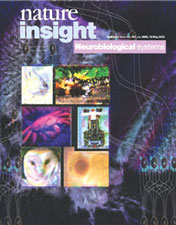Neurobiological
systems
 |
Cover
illustration |
Vol. 417, No. 6886
(16 May 2002).
|![]() PDF
PDF![]() (129
(129![]() K)
K)![]() |
|
In an age of powerful genetic tools to study mice and men, one might wonder why neuroscientists would ever stray from mammalian systems. The molecules-to-behaviour approach has offered important insights into areas of brain research including learning and memory, and disease. But, as Charles Sherrington pointed out almost a century ago in his classic lectures on the Integrated Action of the Nervous System, it is in its functional interconnectivity that the study of the nervous system assumes its due importance. The human brain contains several billion neurons, and several trillion interconnections. On the assumption that there are some common principles of nervous system action — which seems a reasonable proposition from an evolutionary standpoint — attempting to translate circuits to behaviour on the massive human-brain scale poses some significant drawbacks.
Thus, one might argue that the ideal place to begin an integrative understanding of a neural system is one in which the behaviour is particularly well defined and in which the neural circuitry is accessible and can be equally well defined. The reviews in this Insight are meant to sample the advantages of several experimental preparations in elucidating general neural principles. As Eve Marder points out in her overview, there were many more such examples left out than included. Those here span a neuroscientific range from circadian rhythms in Drosophila, for which the molecular backbone is in place to begin teasing apart systems-level questions, to robots based on animal design, created to test our understanding of circuits that are 'solved.' They provide an interesting and varied sample of some of the very elegant neuroscience that is underway outside the mammalian world, and yet affects our understanding of mammalian neuroscience.
Hemai Parthasarathy Senior Editor
| Non-mammalian
models for studying neural development and function EVE MARDER
| 318 | ||
| This article is free to registered users. | |||
| Instructed
learning in the auditory localization pathway of the barn owl ERIC I. KNUDSEN
| 322 | ||
| Circadian
rhythms from flies to human SATCHIDANANDA PANDA, JOHN B. HOGENESCH & STEVE A. KAY
| 329 | ||
| On
the scents of smell in the salamander JOHN S. KAUER
| 336 | ||
| A
small-systems approach to motor pattern generation MICHAEL P. NUSBAUM AND MARK P. BEENHAKKER
| 343 | ||
| What
songbirds teach us about learning MICHAEL S. BRAINARD AND ALLISON J. DOUPE
| 351 | ||
| Robots
in invertebrate neuroscience BARBARA WEBB
| 359 | ||
| All
creatures great and small NIH Institutes
| 364 | ||
| This article is free to registered users. | |||